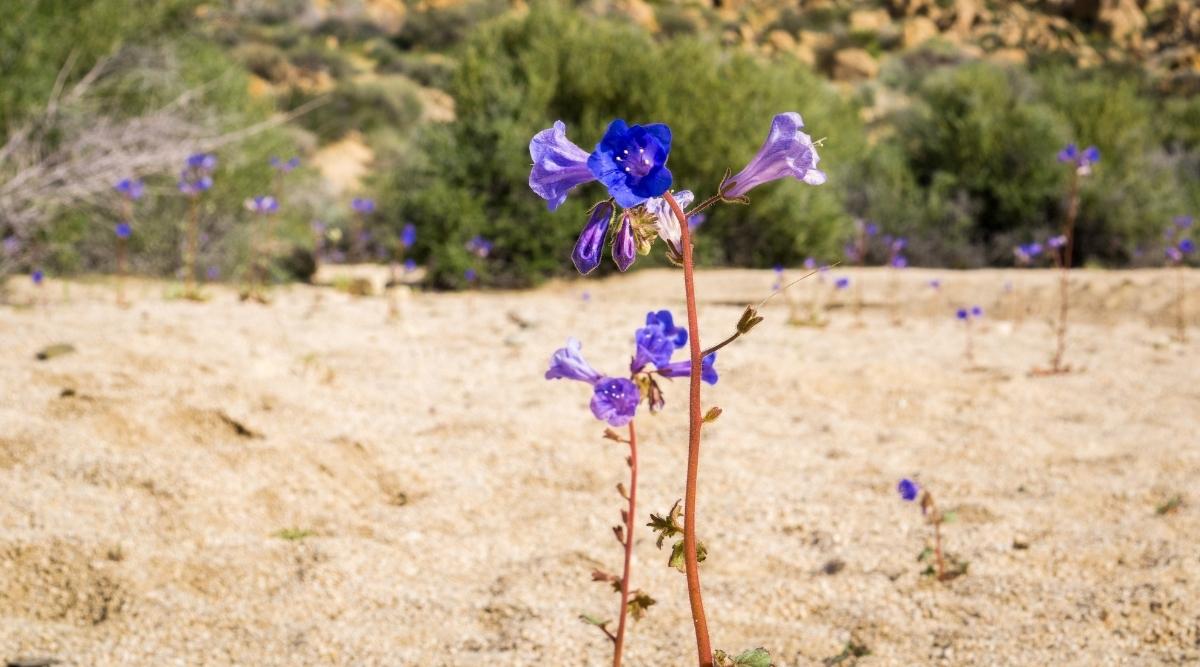
Desert Bluebell, scientifically known as Phacelia campanularia, is a stunning flowering plant that thrives in arid regions, particularly in deserts. Despite its delicate appearance, this resilient plant has a unique set of characteristics that make it truly extraordinary. From its vibrant blue flowers to its ability to adapt to harsh environments, the Desert Bluebell holds numerous secrets waiting to be discovered. In this article, we will delve into the fascinating world of this remarkable plant and unveil 10 extraordinary facts that will undoubtedly leave you amazed. So, buckle up as we embark on a journey through the rugged and awe-inspiring realm of the Desert Bluebell.
Key Takeaways:
- The Desert Bluebell is a resilient plant that survives in harsh deserts with long taproots and stunning blue blooms, attracting pollinators and supporting desert ecosystems.
- Native American tribes value the Desert Bluebell for its medicinal properties and spiritual significance, while conservation efforts aim to protect this extraordinary plant from habitat loss and climate change.
A True Survivor
The Desert Bluebell is well-known for its exceptional ability to survive in extreme arid conditions. With limited access to water, it has adapted by developing long taproots that can reach deep underground, allowing it to efficiently absorb moisture even in the driest of soils.
Eye-Catching Blooms
One of the most remarkable features of the Desert Bluebell is its stunning blue flowers. These bell-shaped blooms form clusters, creating a visually striking display that attracts pollinators such as bees, butterflies, and hummingbirds. The vibrant blue petals serve as a beacon, guiding these creatures to the plant’s nectar-rich center.
Nighttime Blooms
Unlike many other flowers that open during daylight and close at night, the Desert Bluebell blooms in the evening and remains open throughout the night. This unique behavior allows it to adapt to the arid environment by reducing water loss through evaporation during the hot daytime hours.
Native Wisdom
The Desert Bluebell has long been valued by Native American tribes for its medicinal properties and cultural significance. It has been used for its antimicrobial and anti-inflammatory properties and is even believed to have spiritual healing powers.
Drought-Tolerant Marvel
As a true desert dweller, the Desert Bluebell has evolved to withstand prolonged periods of drought. Its ability to store water in its leaves helps it survive through times of extreme water scarcity, allowing it to resume growth and bloom when moisture returns.
Sun-Loving Beauty
The Desert Bluebell thrives in sunny locations and is often found flourishing in open desert areas where it can bask in full sunlight. Its ability to harness the energy of the sun and convert it into vital nutrients through photosynthesis is a testament to its adaptability and resourcefulness.
Ecosystem Support
The Desert Bluebell plays a vital role in desert ecosystems by providing food and habitat for a variety of insects and animals. Its nectar-rich flowers attract pollinators, and its foliage provides a sheltered environment for small creatures seeking protection from the arid environment.
A Generous Pollen Producer
Bees and other pollinators hold a special place in their hearts for the Desert Bluebell. These hardworking insects rely on the plant’s abundant pollen as a vital source of nutrition for their hives. The Desert Bluebell ensures the continuation of its species through this mutually beneficial relationship.
Easy to Cultivate
Whether you have a green thumb or are a novice gardener, the Desert Bluebell is a great choice for cultivation. It thrives in well-draining soil and requires little maintenance once established. Its vibrant blooms will add a pop of color to your garden or landscaping project.
Conservation Efforts
The Desert Bluebell, like many plants of arid regions, faces challenges due to habitat loss and climate change. Conservation efforts are underway to protect and preserve this extraordinary plant, ensuring that future generations can continue to marvel at its beauty and resilience.
In conclusion, the Desert Bluebell is a plant that truly exemplifies strength, beauty, and adaptability. Its ability to thrive in the harshest environments serves as a reminder of nature’s remarkable resilience. So next time you spot the delicate blue flowers of the Desert Bluebell, take a moment to appreciate the extraordinary nature of this incredible plant.
Conclusion
In conclusion, the Desert Bluebell is truly an extraordinary plant. From its vibrant blue flowers to its ability to survive in harsh desert climates, this resilient plant never fails to captivate. Its unique adaptations and medicinal properties make it a valuable addition to any garden or natural setting. Whether you’re a plant enthusiast or simply appreciate the beauty of nature, the Desert Bluebell is definitely a plant worth exploring and learning more about.
FAQs
Q: Where can the Desert Bluebell be found?
A: The Desert Bluebell is native to the southwestern United States and can be found in desert regions such as Arizona, California, and Nevada.
Q: What are the growing requirements for the Desert Bluebell?
A: The Desert Bluebell thrives in sandy or well-drained soil and requires full sunlight. It is a drought-tolerant plant, making it ideal for desert landscapes.
Q: Are Desert Bluebells poisonous?
A: No, Desert Bluebells are not poisonous. In fact, some Native American tribes have used the plant for its medicinal properties, particularly in treating digestive and respiratory ailments.
Q: Can the Desert Bluebell be grown in pots?
A: Yes, the Desert Bluebell can be grown in pots, provided that the pots have proper drainage. It is important to mimic its natural sandy or well-drained soil conditions.
Q: When do Desert Bluebells bloom?
A: Desert Bluebells typically bloom in the spring, usually from March to May, displaying their beautiful blue flowers.
Q: How tall do Desert Bluebells grow?
A: Desert Bluebells can grow up to 1-2 feet in height.
Q: Can Desert Bluebells attract pollinators?
A: Yes, Desert Bluebells are known to attract bees, butterflies, and other pollinators with their vibrant blue flowers, aiding in the pollination process.
Q: Do Desert Bluebells require a lot of maintenance?
A: No, Desert Bluebells are low-maintenance plants. Once established, they require minimal watering and can thrive in dry conditions.
Q: Can Desert Bluebells be grown from seeds?
A: Yes, Desert Bluebells can be grown from seeds. It is recommended to sow the seeds in the fall and allow them to germinate naturally.
Q: Are Desert Bluebells endangered?
A: No, the Desert Bluebell is not currently listed as an endangered species. However, it is important to protect their natural habitats and ensure their conservation for future generations.
Embark on a captivating journey through the world of desert bluebells, uncovering their extraordinary adaptations and vibrant beauty. As you've discovered these fascinating facts about desert bluebells, why not explore the wider realm of wildflowers and their incredible diversity? From their unique survival strategies to their essential roles in ecosystems, wildflowers hold a treasure trove of secrets waiting to be revealed.
Was this page helpful?
Our commitment to delivering trustworthy and engaging content is at the heart of what we do. Each fact on our site is contributed by real users like you, bringing a wealth of diverse insights and information. To ensure the highest standards of accuracy and reliability, our dedicated editors meticulously review each submission. This process guarantees that the facts we share are not only fascinating but also credible. Trust in our commitment to quality and authenticity as you explore and learn with us.


